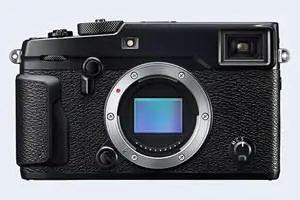Fujifilm X-Pro2 vs Sony RX10 III
The Fujifilm X-Pro2 and the Sony Cyber-shot DSC-RX10 III are two enthusiast cameras that were officially introduced, respectively, in January 2016 and March 2016. The X-Pro2 is a mirrorless interchangeable lens camera, while the RX10 III is a fixed lens compact. The cameras are based on an APS-C (X-Pro2) and an one-inch (RX10 III) sensor. The Fujifilm has a resolution of 24 megapixels, whereas the Sony provides 20 MP.
Below is an overview of the main specs of the two cameras as a starting point for the comparison.

Check X-Pro2 offers at
ebay.com

Check RX10 III offers at
ebay.com
Going beyond this snapshot of core features and characteristics, what are the differences between the Fujifilm X-Pro2 and the Sony Cyber-shot DSC-RX10 III? Which one should you buy? Read on to find out how these two cameras compare with respect to their body size, their imaging sensors, their shooting features, their input-output connections, and their reception by expert reviewers.
Body comparison
An illustration of the physical size and weight of the Fujifilm X-Pro2 and the Sony RX10 III is provided in the side-by-side display below. The two cameras are presented according to their relative size. Three consecutive perspectives from the front, the top, and the back are available. All width, height and depth dimensions are rounded to the nearest millimeter.
The X-Pro2 can be obtained in two different colors (black, graphite), while the RX10 III is only available in black.
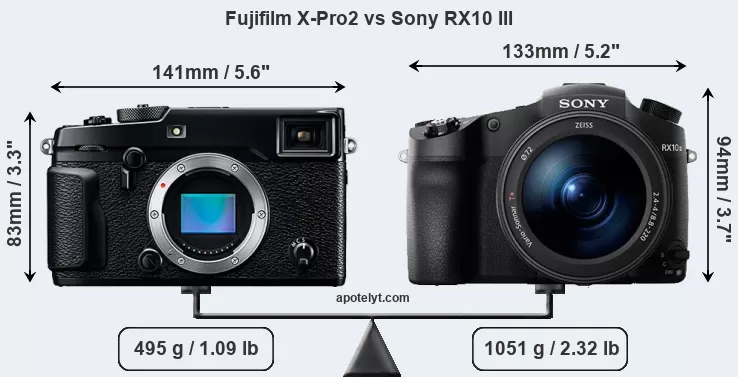
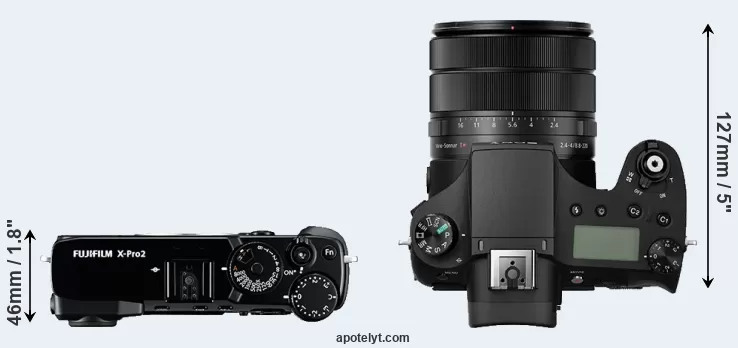
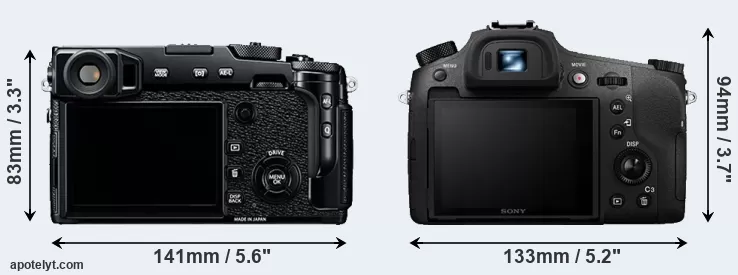
If the front view area (width x height) of the cameras is taken as an aggregate measure of their size, the Sony RX10 III is notably larger (7 percent) than the Fujifilm X-Pro2. In this context, it is worth noting that both cameras are splash and dust-proof and can, hence, be used in inclement weather conditions or harsh environments.
The above size and weight comparisons are to some extent incomplete and possibly misleading, as the RX10 III has a lens built in, whereas the X-Pro2 is an interchangeable lens camera that requires a separate lens. Attaching the latter will add extra weight and bulk to the setup. You can compare the optics available for the X-Pro2 and their specifications in the Fujinon X Lens Catalog.
Concerning battery life, the X-Pro2 gets 350 shots out of its Fujifilm NP-W126 battery, while the RX10 III can take 420 images on a single charge of its Sony NP-FW50 power pack. The power pack in the RX10 III can be charged via the USB port, which can be very convenient when travelling.
The adjacent table lists the principal physical characteristics of the two cameras alongside a wider set of alternatives. If you would like to visualize and compare a different camera combination, you can navigate to the CAM-parator app and make your selection from a broad list of cameras there.

| Camera Model |
Camera Width |
Camera Height |
Camera Depth |
Camera Weight |
Battery Life |
Weather Sealing |
Camera Launch |
Launch Price (USD) |
Street Price |
||
|---|---|---|---|---|---|---|---|---|---|---|---|
| 1. | Fujifilm X-Pro2 | 141 mm | 83 mm | 46 mm | 495 g | 350 | Y | Jan 2016 | 1,699 | ebay.com | |
| 2. | Sony RX10 III | 133 mm | 94 mm | 127 mm | 1051 g | 420 | Y | Mar 2016 | 1,499 | ebay.com | |
| 3. | Fujifilm X-A3 | 117 mm | 67 mm | 40 mm | 339 g | 410 | n | Aug 2016 | 399 | ebay.com | |
| 4. | Fujifilm X-Pro1 | 140 mm | 82 mm | 43 mm | 450 g | 300 | n | Jan 2012 | 1,699 | ebay.com | |
| 5. | Fujifilm X-Pro3 | 141 mm | 83 mm | 46 mm | 497 g | 440 | Y | Oct 2019 | 1,799 | amazon.com | |
| 6. | Fujifilm X-T1 | 129 mm | 90 mm | 47 mm | 440 g | 350 | Y | Jan 2014 | 1,299 | ebay.com | |
| 7. | Fujifilm X-T2 | 133 mm | 92 mm | 49 mm | 507 g | 340 | Y | Jul 2016 | 1,599 | ebay.com | |
| 8. | Fujifilm X-T3 | 133 mm | 93 mm | 59 mm | 539 g | 390 | Y | Sep 2018 | 1,499 | ebay.com | |
| 9. | Fujifilm X100F | 127 mm | 75 mm | 52 mm | 469 g | 390 | n | Jan 2017 | 1,299 | ebay.com | |
| 10. | Fujifilm X100V | 128 mm | 75 mm | 53 mm | 478 g | 420 | Y | Feb 2020 | 1,399 | ebay.com | |
| 11. | Nikon D500 | 147 mm | 115 mm | 81 mm | 860 g | 1240 | Y | Jan 2016 | 1,999 | ebay.com | |
| 12. | Panasonic FZ2500 | 138 mm | 102 mm | 135 mm | 915 g | 350 | n | Sep 2016 | 1,199 | amazon.com | |
| 13. | Sony A6500 | 120 mm | 67 mm | 53 mm | 453 g | 350 | Y | Oct 2016 | 1,399 | ebay.com | |
| 14. | Sony RX10 | 129 mm | 88 mm | 102 mm | 813 g | 420 | Y | Oct 2013 | 1,299 | ebay.com | |
| 15. | Sony RX10 II | 129 mm | 88 mm | 102 mm | 813 g | 400 | Y | Jun 2015 | 1,299 | ebay.com | |
| 16. | Sony RX10 IV | 133 mm | 94 mm | 145 mm | 1095 g | 400 | Y | Sep 2017 | 1,699 | amazon.com | |
| 17. | Sony RX100 V | 102 mm | 58 mm | 41 mm | 299 g | 220 | n | Oct 2016 | 999 | ebay.com | |
| Note: Measurements and pricing do not include easily detachable parts, such as add-on or interchangeable lenses or optional viewfinders. | |||||||||||
Any camera decision will naturally be influenced heavily by the price. The manufacturer’s suggested retail prices give an idea on the placement of the camera in the maker’s lineup and the broader market. The RX10 III was launched at a lower price than the X-Pro2, despite having a lens built in. Usually, retail prices stay at first close to the launch price, but after several months, discounts become available. Later in the product cycle and, in particular, when the replacement model is about to appear, further discounting and stock clearance sales often push the camera price considerably down. Then, after the new model is out, very good deals can frequently be found on the pre-owned market.
Sensor comparison
The imaging sensor is at the core of digital cameras and its size is one of the main determining factors of image quality. A large sensor will tend to have larger individual pixels that provide better low-light sensitivity, wider dynamic range, and richer color-depth than smaller pixel-units in a sensor of the same technological generation. Furthermore, a large sensor camera will give the photographer more possibilities to use shallow depth-of-field in order to isolate a subject from the background. On the downside, larger sensors tend to be associated with larger, more expensive camera bodies and lenses.
Of the two cameras under consideration, the Fujifilm X-Pro2 features an APS-C sensor and the Sony RX10 III an one-inch sensor. The sensor area in the RX10 III is 68 percent smaller. As a result of these sensor size differences, the cameras have a format factor of, respectively, 1.5 and 2.7. Both cameras have a native aspect ratio (sensor width to sensor height) of 3:2.
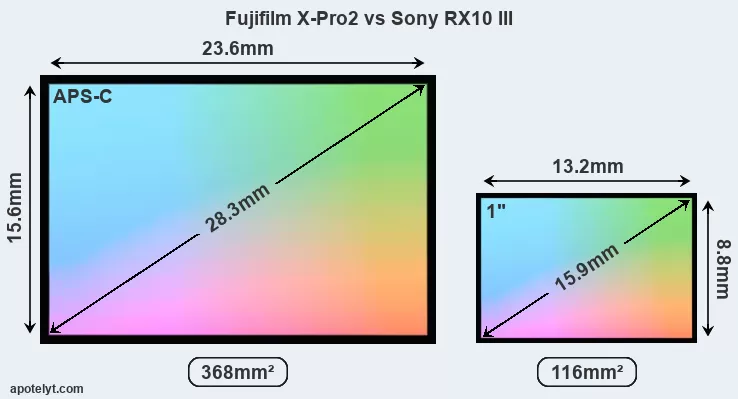
With 24MP, the X-Pro2 offers a higher resolution than the RX10 III (20MP), but the X-Pro2 nevertheless has larger individual pixels (pixel pitch of 3.92μm versus 2.41μm for the RX10 III) due to its larger sensor. It is noteworthy in this context that the two cameras were released in close succession, so that their sensors are from the same technological generation. Coming back to sensor resolution, it should be mentioned that the X-Pro2 has no anti-alias filter installed, so that it can capture all the detail its sensor resolves.
The resolution advantage of the Fujifilm X-Pro2 implies greater flexibility for cropping images or the possibility to print larger pictures. The maximum print size of the X-Pro2 for good quality output (200 dots per inch) amounts to 30 x 20 inches or 76.2 x 50.8 cm, for very good quality (250 dpi) 24 x 16 inches or 61 x 40.6 cm, and for excellent quality (300 dpi) 20 x 13.3 inches or 50.8 x 33.9 cm. The corresponding values for the Sony RX10 III are 27.4 x 18.2 inches or 69.5 x 46.3 cm for good quality, 21.9 x 14.6 inches or 55.6 x 37.1 cm for very good quality, and 18.2 x 12.2 inches or 46.3 x 30.9 cm for excellent quality prints.
The X-Pro2 has on-sensor phase detect pixels, which results in fast and reliable autofocus acquisition even during live view operation.
The Fujifilm X-Pro2 has a native sensitivity range from ISO 200 to ISO 12800, which can be extended to ISO 100-51200. The corresponding ISO settings for the Sony Cyber-shot DSC-RX10 III are ISO 100 to ISO 12800, with the possibility to increase the ISO range to 64-25600.
In terms of underlying technology, the X-Pro2 is build around a CMOS sensor, while the RX10 III uses a BSI-CMOS imager. The X-Pro2 uses Fujifilm's X-Trans layout of photosites, while the RX10 III employs the more common Bayer array.
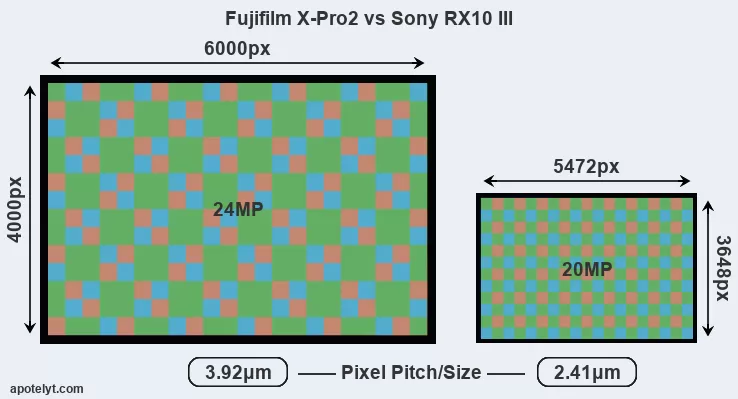
Consistent information on actual sensor performance is available from DXO Mark for many cameras. This service determines an overall sensor rating, as well as sub-scores for low-light sensitivity ("DXO Sports"), dynamic range ("DXO Landscape"), and color depth ("DXO Portrait"). The table below summarizes the physical sensor characteristics and sensor quality findings and compares them across a set of similar cameras.

| Camera Model |
Sensor Class |
Resolution (MP) |
Horiz. Pixels |
Vert. Pixels |
Video Format |
DXO Portrait |
DXO Landscape |
DXO Sports |
DXO Overall |
||
|---|---|---|---|---|---|---|---|---|---|---|---|
| 1. | Fujifilm X-Pro2 | APS-C | 24.0 | 6000 | 4000 | 1080/60p | 23.7 | 13.0 | 1608 | 80 | |
| 2. | Sony RX10 III | 1-inch | 20.0 | 5472 | 3648 | 4K/30p | 23.1 | 12.6 | 472 | 70 | |
| 3. | Fujifilm X-A3 | APS-C | 24.0 | 6000 | 4000 | 1080/60p | 23.8 | 13.1 | 1664 | 81 | |
| 4. | Fujifilm X-Pro1 | APS-C | 16.0 | 4896 | 3264 | 1080/24p | 23.1 | 12.3 | 1238 | 74 | |
| 5. | Fujifilm X-Pro3 | APS-C | 26.0 | 6240 | 4160 | 4K/30p | 24.1 | 13.6 | 1968 | 84 | |
| 6. | Fujifilm X-T1 | APS-C | 16.0 | 4896 | 3264 | 1080/60p | 23.5 | 12.7 | 1426 | 77 | |
| 7. | Fujifilm X-T2 | APS-C | 24.0 | 6000 | 4000 | 4K/30p | 23.8 | 13.1 | 1653 | 81 | |
| 8. | Fujifilm X-T3 | APS-C | 26.0 | 6240 | 4160 | 4K/60p | 24.0 | 13.4 | 1853 | 83 | |
| 9. | Fujifilm X100F | APS-C | 24.0 | 6000 | 4000 | 1080/60p | 23.9 | 13.2 | 1704 | 81 | |
| 10. | Fujifilm X100V | APS-C | 26.0 | 6240 | 4160 | 4K/30p | 24.2 | 13.6 | 1996 | 84 | |
| 11. | Nikon D500 | APS-C | 20.7 | 5568 | 3712 | 4K/30p | 24.0 | 14.0 | 1324 | 83 | |
| 12. | Panasonic FZ2500 | 1-inch | 20.0 | 5472 | 3648 | 4K/30p | 23.0 | 12.6 | 538 | 70 | |
| 13. | Sony A6500 | APS-C | 24.0 | 6000 | 4000 | 4K/30p | 24.5 | 13.7 | 1405 | 85 | |
| 14. | Sony RX10 | 1-inch | 20.0 | 5472 | 3648 | 1080/60p | 22.9 | 12.6 | 474 | 69 | |
| 15. | Sony RX10 II | 1-inch | 20.0 | 5472 | 3648 | 4K/30p | 23.0 | 12.6 | 531 | 70 | |
| 16. | Sony RX10 IV | 1-inch | 20.0 | 5472 | 3648 | 4K/30p | 22.0 | 12.2 | 408 | 63 | |
| 17. | Sony RX100 V | 1-inch | 20.0 | 5472 | 3648 | 4K/30p | 22.8 | 12.4 | 586 | 70 | |
| Note: DXO values in italics represent estimates based on sensor size and age. | |||||||||||
Many modern cameras are not only capable of taking still images, but also of capturing video footage. The two cameras under consideration both have sensors whose read-out speed is fast enough to capture moving pictures, but the RX10 III provides a better video resolution than the X-Pro2. It can shoot movie footage at 4K/30p, while the Fujifilm is limited to 1080/60p.
Feature comparison
Beyond body and sensor, cameras can and do differ across a range of features. The two cameras under consideration are similar with respect to both having an electronic viewfinder. However, the one in the X-Pro2 offers a slightly higher resolution than the one in the RX10 III (2360k vs 2359k dots). The following table reports on some other key feature differences and similarities of the Fujifilm X-Pro2, the Sony RX10 III, and comparable cameras.

| Camera Model |
Viewfinder (Type or 000 dots) |
Control Panel (yes/no) |
LCD Specifications (inch/000 dots) |
LCD Attach- ment |
Touch Screen (yes/no) |
Max Shutter Speed * |
Max Shutter Flaps * |
Built-in Flash (yes/no) |
Built-in Image Stab |
||
|---|---|---|---|---|---|---|---|---|---|---|---|
| 1. | Fujifilm X-Pro2 | 2360 | n | 3.0 / 1620 | fixed | n | 1/8000s | 8.0/s | n | n | |
| 2. | Sony RX10 III | 2359 | Y | 3.0 / 1229 | tilting | n | 1/2000s | 14.0/s | Y | Y | |
| 3. | Fujifilm X-A3 | none | n | 3.0 / 1040 | tilting | Y | 1/4000s | 6.0/s | Y | n | |
| 4. | Fujifilm X-Pro1 | 1440 | n | 3.0 / 1230 | fixed | n | 1/4000s | 6.0/s | n | n | |
| 5. | Fujifilm X-Pro3 | 3690 | n | 3.0 / 1620 | tilting | Y | 1/8000s | 8.0/s | n | n | |
| 6. | Fujifilm X-T1 | 2360 | n | 3.0 / 1040 | tilting | n | 1/4000s | 8.0/s | n | n | |
| 7. | Fujifilm X-T2 | 2360 | n | 3.0 / 1040 | full-flex | n | 1/8000s | 8.0/s | n | n | |
| 8. | Fujifilm X-T3 | 3690 | n | 3.0 / 1040 | full-flex | Y | 1/8000s | 11.0/s | n | n | |
| 9. | Fujifilm X100F | 2360 | n | 3.0 / 1040 | fixed | n | 1/4000s | 8.0/s | Y | n | |
| 10. | Fujifilm X100V | 3690 | n | 3.0 / 1620 | tilting | Y | 1/4000s | 11.0/s | n | n | |
| 11. | Nikon D500 | optical | Y | 3.2 / 2359 | tilting | Y | 1/8000s | 10.0/s | n | n | |
| 12. | Panasonic FZ2500 | 2360 | n | 3.0 / 1040 | swivel | Y | 1/4000s | 12.0/s | Y | Y | |
| 13. | Sony A6500 | 2359 | n | 3.0 / 922 | tilting | Y | 1/4000s | 11.0/s | Y | Y | |
| 14. | Sony RX10 | 1440 | Y | 3.0 / 1229 | tilting | n | 1/3200s | 10.0/s | Y | Y | |
| 15. | Sony RX10 II | 2359 | Y | 3.0 / 1229 | tilting | n | 1/3200s | 14.0/s | Y | Y | |
| 16. | Sony RX10 IV | 2359 | Y | 3.0 / 1440 | tilting | Y | 1/2000s | 24.0/s | Y | Y | |
| 17. | Sony RX100 V | 2359 | n | 3.0 / 1229 | tilting | n | 1/2000s | 24.0/s | Y | Y | |
| Note: *) Information refers to the mechanical shutter, unless the camera only has an electronic one. | |||||||||||
One feature that is present on the RX10 III, but is missing on the X-Pro2 is a top-level LCD. While being, of course, smaller than the rear screen, the control panel conveys some of the essential shooting information and can be convenient for quick and easy settings verification.
The reported shutter speed information refers to the use of the mechanical shutter. Yet, some cameras only have an electronic shutter, while others have an electronic shutter in addition to a mechanical one. In fact, both cameras under consideration feature an electronic shutter, which makes completely silent shooting possible. However, this mode is less suitable for photographing moving objects (risk of rolling shutter) or shooting under artificial light sources (risk of flickering).
The Fujifilm X-Pro2 has an intervalometer built-in. This enables the photographer to capture time lapse sequences, such as flower blooming, a sunset or moon rise, without purchasing an external camera trigger and related software.
The X-Pro2 writes its imaging data to SDXC cards, while the RX10 III uses SDXC or Memory Stick PRO Duo cards. The X-Pro2 features dual card slots, which can be very useful in case a memory card fails. In contrast, the RX10 III only has one slot. The X-Pro2 supports UHS-II cards (on its first slot), while the RX10 III can use UHS-I cards.
Connectivity comparison
For some imaging applications, the extent to which a camera can communicate with its environment can be an important aspect in the camera decision process. The table below provides an overview of the connectivity of the Fujifilm X-Pro2 and Sony Cyber-shot DSC-RX10 III and, in particular, the interfaces the cameras (and selected comparators) provide for accessory control and data transfer.

| Camera Model |
Hotshoe Port |
Internal Mic / Speaker |
Microphone Port |
Headphone Port |
HDMI Port |
USB Port |
WiFi Support |
NFC Support |
Bluetooth Support |
||
|---|---|---|---|---|---|---|---|---|---|---|---|
| 1. | Fujifilm X-Pro2 | Y | stereo / mono | Y | - | micro | 2.0 | Y | - | - | |
| 2. | Sony RX10 III | Y | stereo / mono | Y | Y | micro | 2.0 | Y | Y | - | |
| 3. | Fujifilm X-A3 | Y | stereo / mono | - | - | micro | 2.0 | Y | - | - | |
| 4. | Fujifilm X-Pro1 | Y | stereo / mono | - | - | mini | 2.0 | - | - | - | |
| 5. | Fujifilm X-Pro3 | Y | stereo / mono | Y | - | - | 3.1 | Y | - | Y | |
| 6. | Fujifilm X-T1 | Y | stereo / mono | Y | - | mini | 2.0 | Y | - | - | |
| 7. | Fujifilm X-T2 | Y | stereo / mono | Y | - | micro | 3.0 | Y | - | - | |
| 8. | Fujifilm X-T3 | Y | stereo / mono | Y | Y | micro | 3.1 | Y | - | Y | |
| 9. | Fujifilm X100F | Y | stereo / mono | Y | - | micro | 2.0 | Y | - | - | |
| 10. | Fujifilm X100V | Y | stereo / mono | Y | - | micro | 3.1 | Y | - | Y | |
| 11. | Nikon D500 | Y | stereo / mono | Y | Y | mini | 3.0 | Y | Y | Y | |
| 12. | Panasonic FZ2500 | Y | stereo / mono | Y | Y | micro | 2.0 | Y | - | - | |
| 13. | Sony A6500 | Y | stereo / mono | Y | - | micro | 2.0 | Y | Y | - | |
| 14. | Sony RX10 | Y | stereo / mono | Y | Y | micro | 2.0 | Y | Y | - | |
| 15. | Sony RX10 II | Y | stereo / mono | Y | Y | micro | 2.0 | Y | Y | - | |
| 16. | Sony RX10 IV | Y | stereo / mono | Y | Y | micro | 2.0 | Y | Y | - | |
| 17. | Sony RX100 V | - | stereo / mono | - | - | micro | 2.0 | Y | Y | - |
Studio photographers will appreciate that the Fujifilm X-Pro2 (unlike the RX10 III) features a PC Sync socket, so that professional strobe lights can be controlled by the camera.
Both the X-Pro2 and the RX10 III have been discontinued, but can regularly be found used on ebay. The X-Pro2 was replaced by the Fujifilm X-Pro3, while the RX10 III was followed by the Sony RX10 IV. Further information on the features and operation of the X-Pro2 and RX10 III can be found, respectively, in the Fujifilm X-Pro2 Manual (free pdf) or the online Sony RX10 III Manual.
Review summary
So what is the bottom line? Is there a clear favorite between the Fujifilm X-Pro2 and the Sony RX10 III? Which camera is better? A synthesis of the relative strong points of each of the models is listed below.

Arguments in favor of the Fujifilm X-Pro2:
- More detail: Offers more megapixels (24 vs 20MP) with a 10% higher linear resolution.
- Maximized detail: Lacks an anti-alias filter to exploit the sensor's full resolution potential.
- Better image quality: Features bigger pixels on a larger sensor for higher quality imaging.
- Richer colors: The pixel size advantage translates into images with better, more accurate colors.
- More dynamic range: Larger pixels capture a wider spectrum of light and dark details.
- Better low-light sensitivity: Larger pixels means good image quality even under poor lighting.
- Better live-view autofocus: Features on-sensor phase-detection for more confident autofocus.
- More detailed LCD: Has a higher resolution rear screen (1620k vs 1229k dots).
- Faster shutter: Has higher mechanical shutter speed (1/8000s vs 1/2000s) to freeze action.
- Easier time-lapse photography: Has an intervalometer built-in for low frequency shooting.
- More flexible: Accepts interchangeable lenses, so that lens characteristics can be altered.
- Better studio light control: Has a PC Sync socket to connect to professional strobe lights.
- Greater peace of mind: Features a second card slot as a backup in case of memory card failure.
- Faster buffer clearing: Supports a more advanced SD data transfer standard (UHS-II vs UHS-I).

Reasons to prefer the Sony Cyber-shot DSC-RX10 III:
- Better moiré control: Has an anti-alias filter to avoid artificial patterns to appear in images.
- Better video: Provides higher definition movie capture (4K/30p vs 1080/60p).
- Better sound control: Has a headphone port that enables audio monitoring while recording.
- Larger viewfinder image: Features a viewfinder with a higher magnification (0.70x vs 0.39x).
- Easier setting verification: Features a control panel on top to check shooting parameters.
- More flexible LCD: Has a tilting screen for odd-angle shots in landscape orientation.
- Faster burst: Shoots at higher frequency (14 vs 8 flaps/sec) to capture the decisive moment.
- Ready to shoot: Has an integrated lens, whereas the X-Pro2 necessitates an extra lens.
- Longer lasting: Gets more shots (420 versus 350) out of a single battery charge.
- Easier travel charging: Can be conveniently charged via its USB port.
- Sharper images: Has stabilization technology built-in to reduce the impact of hand-shake.
- Easier fill-in: Has a small integrated flash to brighten shadows of backlit subjects.
- Easier device pairing: Supports NFC for fast wireless image transfer over short distances.
- More affordable: Was introduced at a lower price, despite coming with a built-in lens.
If the number of relative strengths (bullet points above) is taken as a guide, the match-up finishes in a tie (14 points each). However, the relative importance of the various individual camera aspects will vary according to personal preferences and needs, so that you might like to apply corresponding weights to the particular features before making a decision on a new camera. A professional sports photographer will view the differences between cameras in a way that diverges from the perspective of a street photog, and a person interested in family portraits has distinct needs from a landscape shooter. Hence, the decision which camera is best and worth buying is often a very personal one.
How about other alternatives? Do the specifications of the Fujifilm X-Pro2 and the Sony RX10 III place the cameras among the top in their class? Find out in the latest Best Mirrorless Interchangeable Lens Camera and Best Superzoom Camera listings whether the two cameras rank among the cream of the crop.
In any case, while the comparison of the spec-sheets of cameras can offer a general idea of their imaging potential, it remains partial and cannot reveal, for example, the shooting experience and imaging performance when actually working with the X-Pro2 or the RX10 III. User reviews that are available, for instance, at amazon can sometimes shed light on these issues, but such feedback is all too often partial, inconsistent, and inaccurate.
Expert reviews
This is why hands-on reviews by experts are important. The following table reports the overall ratings of the cameras as published by some of the major camera review sites (amateurphotographer [AP], cameralabs [CL], digitalcameraworld [DCW], dpreview [DPR], ephotozine [EPZ], photographyblog [PB]). As can be seen, the professional reviewers agree in many cases on the quality of different cameras, but sometimes their assessments diverge, reinforcing the earlier point that a camera decision is often a very personal choice.

| Camera Model |
AP score |
CL score |
DCW score |
DPR score |
EPZ score |
PB score |
Camera Launch |
Launch Price (USD) |
Street Price |
||
|---|---|---|---|---|---|---|---|---|---|---|---|
| 1. | Fujifilm X-Pro2 | .. | + | .. | 83/100 | 4.5/5 | 4.5/5 | Jan 2016 | 1,699 | ebay.com | |
| 2. | Sony RX10 III | 5/5 | + | .. | 84/100 | 4.5/5 | 4.5/5 | Mar 2016 | 1,499 | ebay.com | |
| 3. | Fujifilm X-A3 | .. | .. | .. | 74/100 | 4.5/5 | 4/5 | Aug 2016 | 399 | ebay.com | |
| 4. | Fujifilm X-Pro1 | 5/5 | + + | .. | 79/100 | 4.5/5 | 4.5/5 | Jan 2012 | 1,699 | ebay.com | |
| 5. | Fujifilm X-Pro3 | 4/5 | + | 4/5 | 85/100 | 4/5 | .. | Oct 2019 | 1,799 | amazon.com | |
| 6. | Fujifilm X-T1 | 5/5 | + + | .. | 84/100 | 5/5 | 5/5 | Jan 2014 | 1,299 | ebay.com | |
| 7. | Fujifilm X-T2 | 5/5 | + + | .. | 86/100 | 4.5/5 | 5/5 | Jul 2016 | 1,599 | ebay.com | |
| 8. | Fujifilm X-T3 | 5/5 | + + | 4.5/5 | 88/100 | 5/5 | 5/5 | Sep 2018 | 1,499 | ebay.com | |
| 9. | Fujifilm X100F | 5/5 | + | 3.9/5 | 83/100 | 4.5/5 | 4.5/5 | Jan 2017 | 1,299 | ebay.com | |
| 10. | Fujifilm X100V | 5/5 | + + | 4.5/5 | 86/100 | 5/5 | 4.5/5 | Feb 2020 | 1,399 | ebay.com | |
| 11. | Nikon D500 | 5/5 | + + | 4.7/5 | 91/100 | 4.5/5 | 5/5 | Jan 2016 | 1,999 | ebay.com | |
| 12. | Panasonic FZ2500 | .. | + | .. | 82/100 | 4.5/5 | 5/5 | Sep 2016 | 1,199 | amazon.com | |
| 13. | Sony A6500 | 5/5 | + + | 3.5/5 | 85/100 | 4.5/5 | 4.5/5 | Oct 2016 | 1,399 | ebay.com | |
| 14. | Sony RX10 | 5/5 | + | .. | 80/100 | 4.5/5 | 4.5/5 | Oct 2013 | 1,299 | ebay.com | |
| 15. | Sony RX10 II | 5/5 | + + | .. | 82/100 | 4.5/5 | 4/5 | Jun 2015 | 1,299 | ebay.com | |
| 16. | Sony RX10 IV | 5/5 | + | 3.5/5 | 84/100 | 4.5/5 | 5/5 | Sep 2017 | 1,699 | amazon.com | |
| 17. | Sony RX100 V | 4.5/5 | + + | .. | 83/100 | 4/5 | 4.5/5 | Oct 2016 | 999 | ebay.com | |
| Note: (+ +) highly recommended; (+) recommended; (o) reviewed; (..) not available. | |||||||||||
The above review scores should be interpreted with care, though. The assessments were made in relation to similar cameras of the same technological generation. Thus, a score needs to be put into the context of the launch date and the launch price of the camera, and rating-comparisons among cameras that span long time periods or concern very differently equipped models make little sense. It should also be noted that some of the review sites have over time altered the way they render their verdicts.

Check X-Pro2 offers at
ebay.com

Check RX10 III offers at
ebay.com
Other camera comparisons
Did this review help to inform your camera decision process? If you would like to see a different side-by-side camera review, just make a corresponding selection in the search boxes below. Alternatively, you can follow any of the listed hyperlinks for comparisons that others found interesting.
- Canon 700D vs Sony RX10 III
- Fujifilm X-Pro2 vs Leica V-LUX 2
- Fujifilm X-Pro2 vs Leica X-U Typ 113
- Fujifilm X-Pro2 vs Olympus E-450
- Fujifilm X-Pro2 vs Olympus E-P2
- Fujifilm X-Pro2 vs Sony A7R III
- Fujifilm X-Pro2 vs Sony RX1R
- Fujifilm X-T1 vs Sony RX10 III
- Nikon D70s vs Sony RX10 III
- Nikon Z6 vs Sony RX10 III
- Olympus TG-4 vs Sony RX10 III
- Sony NEX-3 vs Sony RX10 III
Specifications: Fujifilm X-Pro2 vs Sony RX10 III
Below is a side-by-side comparison of the specs of the two cameras to facilitate a quick review of their differences and common features.
| Camera Model | Fujifilm X-Pro2 | Sony RX10 III |
|---|---|---|
| Camera Type | Mirrorless system camera | Fixed lens compact camera |
| Camera Lens | Fujifilm X mount lenses | 24-600mm f/2.4-4.0 |
| Launch Date | January 2016 | March 2016 |
| Launch Price | USD 1,699 | USD 1,499 |
| Sensor Specs | Fujifilm X-Pro2 | Sony RX10 III |
| Sensor Technology | CMOS | BSI-CMOS |
| Sensor Format | APS-C Sensor | 1" Sensor |
| Sensor Size | 23.6 x 15.6 mm | 13.2 x 8.8 mm |
| Sensor Area | 368.16 mm2 | 116.16 mm2 |
| Sensor Diagonal | 28.3 mm | 15.9 mm |
| Crop Factor | 1.5x | 2.7x |
| Sensor Resolution | 24 Megapixels | 20 Megapixels |
| Image Resolution | 6000 x 4000 pixels | 5472 x 3648 pixels |
| Pixel Pitch | 3.92 μm | 2.41 μm |
| Pixel Density | 6.52 MP/cm2 | 17.18 MP/cm2 |
| Moiré control | no AA filter | Anti-Alias filter |
| Movie Capability | 1080/60p Video | 4K/30p Video |
| ISO Setting | 200 - 12,800 ISO | 100 - 12,800 ISO |
| ISO Boost | 100 - 51,200 ISO | 64 - 25,600 ISO |
| Image Processor | X Processor Pro | BIONZ X |
| DXO Sensor Quality (score) | .. | 70 |
| DXO Color Depth (bits) | .. | 23.1 |
| DXO Dynamic Range (EV) | .. | 12.6 |
| DXO Low Light (ISO) | .. | 472 |
| Screen Specs | Fujifilm X-Pro2 | Sony RX10 III |
| Viewfinder Type | Electronic viewfinder | Electronic viewfinder |
| Viewfinder Field of View | 100% | 100% |
| Viewfinder Magnification | 0.39x | 0.70x |
| Viewfinder Resolution | 2360k dots | 2359k dots |
| Top-Level Screen | no Top Display | Control Panel |
| LCD Framing | Live View | Live View |
| Rear LCD Size | 3.0inch | 3.0inch |
| LCD Resolution | 1620k dots | 1229k dots |
| LCD Attachment | Fixed screen | Tilting screen |
| Shooting Specs | Fujifilm X-Pro2 | Sony RX10 III |
| Focus System | On-Sensor Phase-detect | Contrast-detect AF |
| Manual Focusing Aid | Focus Peaking | Focus Peaking |
| Max Shutter Speed (mechanical) | 1/8000s | 1/2000s |
| Continuous Shooting | 8 shutter flaps/s | 14 shutter flaps/s |
| Electronic Shutter | up to 1/32000s | up to 1/32000s |
| Time-Lapse Photography | Intervalometer built-in | no Intervalometer |
| Fill Flash | no On-Board Flash | Built-in Flash |
| Storage Medium | SDXC cards | MS or SDXC cards |
| Single or Dual Card Slots | Dual card slots | Single card slot |
| UHS card support | Single UHS-II | UHS-I |
| Connectivity Specs | Fujifilm X-Pro2 | Sony RX10 III |
| External Flash | Hotshoe | Hotshoe |
| Studio Flash | PC Sync socket | no PC Sync |
| USB Connector | USB 2.0 | USB 2.0 |
| HDMI Port | micro HDMI | micro HDMI |
| Microphone Port | External MIC port | External MIC port |
| Headphone Socket | no Headphone port | Headphone port |
| Wifi Support | Wifi built-in | Wifi built-in |
| Near-Field Communication | no NFC | NFC built-in |
| Body Specs | Fujifilm X-Pro2 | Sony RX10 III |
| Environmental Sealing | Weathersealed body | Weathersealed body |
| Battery Type | Fujifilm NP-W126 | Sony NP-FW50 |
| Battery Life (CIPA) | 350 shots per charge | 420 shots per charge |
| In-Camera Charging | no USB charging | USB charging |
| Body Dimensions |
141 x 83 x 46 mm (5.6 x 3.3 x 1.8 in) |
133 x 94 x 127 mm (5.2 x 3.7 x 5.0 in) |
| Camera Weight | 495 g (17.5 oz) | 1051 g (37.1 oz) |

Check X-Pro2 offers at
ebay.com

Check RX10 III offers at
ebay.com
Did you notice an error on this page? If so, please get in touch, so that we can correct the information.
